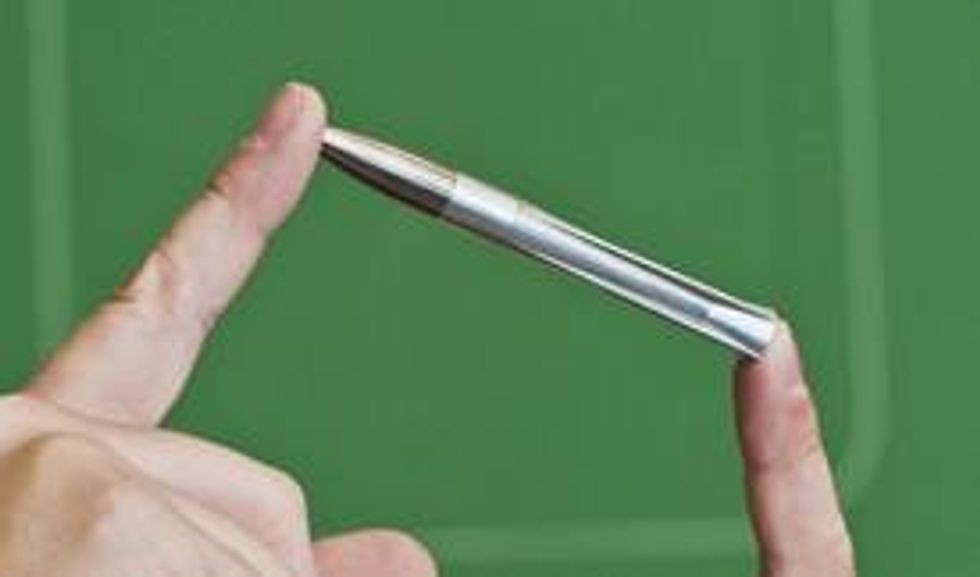Going Backwards: Self-Guided Bullets Unveiled
'Securing a Peaceful and Free World Through Technology.' Not.
The U.S. military has been after self-guided bullets for years.
Now Sandia National Labs has announced today that their engineers have invented a dart-like, self-guided bullet for small-caliber, smooth-bore firearms that could hit laser-designated targets at distances of more than a mile.
Sandia National Laboratories, which claims to be "Securing a Peaceful and Free World Through Technology," is operated and managed by Sandia Corporation, a wholly owned subsidiary of Lockheed Martin Corporation, for the US Department of Energy's National Nuclear Security Administration.
Lockheed's been a longtime partner in the military's quest for the ultimate self-guided bullet. In 2008, they scored a $14.5 million contract as part of the US DARPA's (Defense Advanced Research Projects Agency) "Exacto" (Extreme Accuracy Tasked Ordinance) program, which sought to develop sniper rifles with guided bullets.
* * *
Their dart-like rifle round is designed for small-caliber firearms like those carried by the average grunt or law enforcement officer. [...]

* * *
From the Sandia National Labs news release:
"We have a very promising technology to guide small projectiles that could be fully developed inexpensively and rapidly"[...]
Potential customers for the bullet include the military, law enforcement and recreational shooters, Sandia says.Most bullets shot from rifles, which have grooves, or rifling, that cause them to spin so they fly straight, like a long football pass. To enable a bullet to turn in flight toward a target and to simplify the design, the spin had to go, Jones said.
The bullet flies straight due to its aerodynamically stable design, which consists of a center of gravity that sits forward in the projectile and tiny fins that enable it to fly without spin, just as a dart does, he said.
Computer aerodynamic modeling shows the design would result in dramatic improvements in accuracy, Jones said. Computer simulations showed an unguided bullet under real-world conditions could miss a target more than a half mile away (1,000 meters away) by 9.8 yards (9 meters), but a guided bullet would get within 8 inches (0.2 meters), according to the patent.
Plastic sabots provide a gas seal in the cartridge and protect the delicate fins until they drop off after the bullet emerges from the firearm's barrel.
Potential customers for the bullet include the military, law enforcement and recreational shooters.
* * *
# # #
An Urgent Message From Our Co-Founder
Dear Common Dreams reader, The U.S. is on a fast track to authoritarianism like nothing I've ever seen. Meanwhile, corporate news outlets are utterly capitulating to Trump, twisting their coverage to avoid drawing his ire while lining up to stuff cash in his pockets. That's why I believe that Common Dreams is doing the best and most consequential reporting that we've ever done. Our small but mighty team is a progressive reporting powerhouse, covering the news every day that the corporate media never will. Our mission has always been simple: To inform. To inspire. And to ignite change for the common good. Now here's the key piece that I want all our readers to understand: None of this would be possible without your financial support. That's not just some fundraising cliche. It's the absolute and literal truth. We don't accept corporate advertising and never will. We don't have a paywall because we don't think people should be blocked from critical news based on their ability to pay. Everything we do is funded by the donations of readers like you. Will you donate now to help power the nonprofit, independent reporting of Common Dreams? Thank you for being a vital member of our community. Together, we can keep independent journalism alive when it’s needed most. - Craig Brown, Co-founder |
The U.S. military has been after self-guided bullets for years.
Now Sandia National Labs has announced today that their engineers have invented a dart-like, self-guided bullet for small-caliber, smooth-bore firearms that could hit laser-designated targets at distances of more than a mile.
Sandia National Laboratories, which claims to be "Securing a Peaceful and Free World Through Technology," is operated and managed by Sandia Corporation, a wholly owned subsidiary of Lockheed Martin Corporation, for the US Department of Energy's National Nuclear Security Administration.
Lockheed's been a longtime partner in the military's quest for the ultimate self-guided bullet. In 2008, they scored a $14.5 million contract as part of the US DARPA's (Defense Advanced Research Projects Agency) "Exacto" (Extreme Accuracy Tasked Ordinance) program, which sought to develop sniper rifles with guided bullets.
* * *
Their dart-like rifle round is designed for small-caliber firearms like those carried by the average grunt or law enforcement officer. [...]

* * *
From the Sandia National Labs news release:
"We have a very promising technology to guide small projectiles that could be fully developed inexpensively and rapidly"[...]
Potential customers for the bullet include the military, law enforcement and recreational shooters, Sandia says.Most bullets shot from rifles, which have grooves, or rifling, that cause them to spin so they fly straight, like a long football pass. To enable a bullet to turn in flight toward a target and to simplify the design, the spin had to go, Jones said.
The bullet flies straight due to its aerodynamically stable design, which consists of a center of gravity that sits forward in the projectile and tiny fins that enable it to fly without spin, just as a dart does, he said.
Computer aerodynamic modeling shows the design would result in dramatic improvements in accuracy, Jones said. Computer simulations showed an unguided bullet under real-world conditions could miss a target more than a half mile away (1,000 meters away) by 9.8 yards (9 meters), but a guided bullet would get within 8 inches (0.2 meters), according to the patent.
Plastic sabots provide a gas seal in the cartridge and protect the delicate fins until they drop off after the bullet emerges from the firearm's barrel.
Potential customers for the bullet include the military, law enforcement and recreational shooters.
* * *
# # #
The U.S. military has been after self-guided bullets for years.
Now Sandia National Labs has announced today that their engineers have invented a dart-like, self-guided bullet for small-caliber, smooth-bore firearms that could hit laser-designated targets at distances of more than a mile.
Sandia National Laboratories, which claims to be "Securing a Peaceful and Free World Through Technology," is operated and managed by Sandia Corporation, a wholly owned subsidiary of Lockheed Martin Corporation, for the US Department of Energy's National Nuclear Security Administration.
Lockheed's been a longtime partner in the military's quest for the ultimate self-guided bullet. In 2008, they scored a $14.5 million contract as part of the US DARPA's (Defense Advanced Research Projects Agency) "Exacto" (Extreme Accuracy Tasked Ordinance) program, which sought to develop sniper rifles with guided bullets.
* * *
Their dart-like rifle round is designed for small-caliber firearms like those carried by the average grunt or law enforcement officer. [...]

* * *
From the Sandia National Labs news release:
"We have a very promising technology to guide small projectiles that could be fully developed inexpensively and rapidly"[...]
Potential customers for the bullet include the military, law enforcement and recreational shooters, Sandia says.Most bullets shot from rifles, which have grooves, or rifling, that cause them to spin so they fly straight, like a long football pass. To enable a bullet to turn in flight toward a target and to simplify the design, the spin had to go, Jones said.
The bullet flies straight due to its aerodynamically stable design, which consists of a center of gravity that sits forward in the projectile and tiny fins that enable it to fly without spin, just as a dart does, he said.
Computer aerodynamic modeling shows the design would result in dramatic improvements in accuracy, Jones said. Computer simulations showed an unguided bullet under real-world conditions could miss a target more than a half mile away (1,000 meters away) by 9.8 yards (9 meters), but a guided bullet would get within 8 inches (0.2 meters), according to the patent.
Plastic sabots provide a gas seal in the cartridge and protect the delicate fins until they drop off after the bullet emerges from the firearm's barrel.
Potential customers for the bullet include the military, law enforcement and recreational shooters.
* * *
# # #

